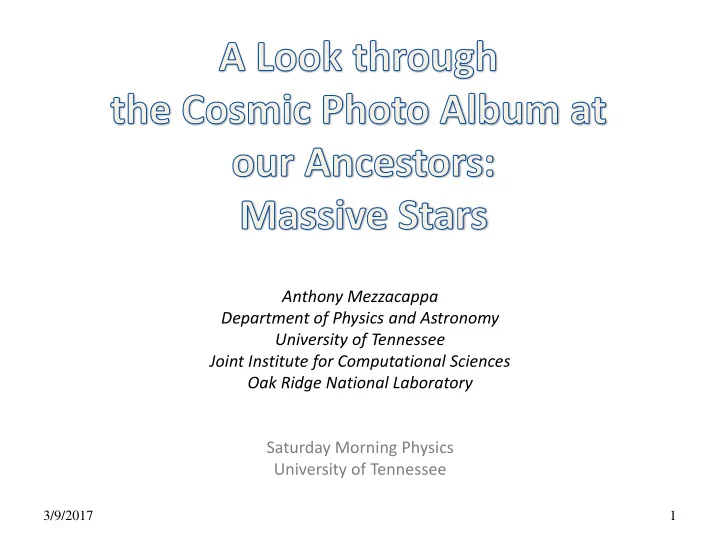

Anthony Mezzacappa Department of Physics and Astronomy University of Tennessee Joint Institute for Computational Sciences Oak Ridge National Laboratory Saturday Morning Physics University of Tennessee 3/9/2017 1
Universe Evolution of the Universe as a whole. Large-Scale Structure Filaments of clusters and “ superclusters ” of galaxies. Galaxies Formation and evolution of individual galaxies. Stars and Planets Formation and evolution of stars and solar systems. Stellar Death: Supernovae Compact Objects Formation and evolution of neutron stars and black holes. Understanding our universe and our place in it will require an understanding of phenomena on all scales. 3/9/2017 2
How did galaxies and clusters and superclusters form? 3/9/2017 3
3/9/2017 4
Number of Zeros Name 10 24 Septillion 10 21 Sextillion 10 18 Quintillion 10 15 Quadrillion 10 12 Trillion 10 9 Billion 10 6 Million 10 3 Thousand 6 x 10 23 Mole (600 Sextillion) 3/9/2017 5
• How many galaxies are there in the Universe? 100 Billion – 1000 Billion (1 Trillion) o • How many stars are there in the Universe? 10 Sextillion – 1000 Sextillion (1 Septillion)! o About 1/10 Mole o How many water molecules are there in a • drop of water? 1 Sextillion o 1/100 Mole o 3/9/2017 6
3/9/2017 7
3/9/2017 8
If a (C-O) white dwarf is near another star, matter from the other star is gravitationally attracted to the white dwarf, and the Chandrasekhar Mass is exceeded. The white dwarf collapses, which initiates a thermonuclear runaway and generates a thermonuclear supernova. There is a maximum mass for white dwarf stars known as the Chandrasekhar Mass. The other kind of supernova, a core collapse supernova, 3/9/2017 9 is what we will discuss today.
Speed of Light o 671,000,000 miles per hour. o Around the Earth o 0.1 seconds o From Earth to the Moon 1.3 seconds o From Earth to the Sun 8.3 minutes o From Earth to Proxima Centauri (the closest star to our Sun) 4.2 years 1 Light Year is about 6,000,000,000,000 miles! 3/9/2017 10
SN185: First supernova recorded by humankind, recorded by Chinese astronomers. SN1006: Brightest supernova ever recorded, recorded by Chinese. (~7200 ly) SN1054: Crab Supernova (~6500 ly) SN1572: Tycho ’ s Supernova (~7500 ly) SN1604: Kepler ’ s Supernova (~20,000 ly) 1006: Thermonuclear 1054: Core Collapse 1572: Thermonuclear 1604: Thermonuclear Last supernova in Milky Way seen with naked eye. Changed humankind’s view of the Universe! 3/9/2017 11
Supernovae shine as brightly as their host galaxies. First, and only, time we’ve seen the neutrinos from such an event. 3/9/2017 12
Constellation: Cassiopeia Distance: 11,000 ly Shell expanding at 10 million MPH. Hubble (Optical) 18,000 0 F Chandra (X-Ray) 18,000,000 0 F Chandra (X-Ray) Spitzer (IR) 10 Light Years 50 0 F 3/9/2017 13
< 700 ly < 900 ly 3/9/2017 14
3/9/2017 15
3/9/2017 16
Red ochre—Fe2O3—is a simple compound of iron and oxygen that absorbs yellow, green, and blue light and appears red. It’s what makes red paint red. 3/9/2017 17
Core Collapse Supernova Paradigm and Problem Description 3/9/2017 18
Transition from nuclei to nuclear matter occurs through a “ pasta ” phase. 3/9/2017 19
How is the supernova shock w ave revived? the most fundamental question in supernova theory Leading Roles Gravity Neutrinos Convection Standing Accretion Shock Instability (SASI) Supporting Roles Nuclear Burning Rotation Magnetic Fields 3/9/2017 20
44 key weak interactions Shocked Hot Unshocked Mantle Cold Core Neutrinospheres 8 key weak 3/9/2017 21 interactions
3/9/2017 22
3/9/2017 23
Gravitational Waves Photons (Light) Neutrinos 3/9/2017 24
3/9/2017 25
3/9/2017 26
3/9/2017 27
3/9/2017 28
Infinite Number of Points Finite Number of Points 3/9/2017 29
Initial New Computer State of State of Repeat Code the Star the Star We need to solve the equations of We represent We solve these physics to get the equations of algebraic Laws of Algebraic Computer the new state of physics as equations to get Physics Equations Code the star given algebraic the new state of the old state of equations. the star. the star. 3/9/2017 30
Gravitational Waves Photons (Light) Neutrinos 3/9/2017 31
Gravity is the result of curved space! Orbits result from spatial curvature. • (In the case of the Sun-Earth or Earth-Moon systems, it’s the curvature of space-time that matters.) Space is physical! It’s a fabric! And you can have waves propagating across it! 3/9/2017 32
3/9/2017 33
Laser Interferometer Gravitational Wave Observatory (LIGO) LIGO Hanford Gravitational waves are quadrupolar. Test masses will move less than the LIGO Livingston diameter of a proton! Sources: Core Collapse Supernovae, Neutron-Star Mergers, Black Hole Mergers 3/9/2017 34
Theory Computation Experiment and Observation Knowledge of Our 3/9/2017 35 Cosmic Origins
“Per aspera ad astra.” Lucius Annaeus Seneca Roman Philosopher, Statesman, Dramatist 4 BC – 65 AD 3/9/2017 36
Recommend
More recommend